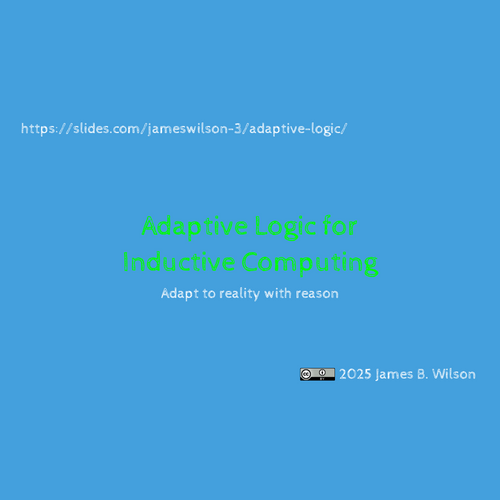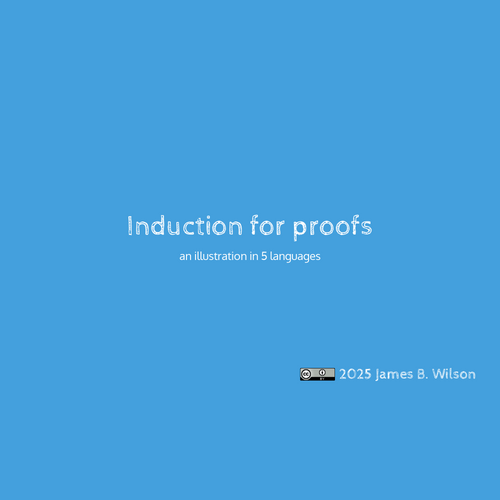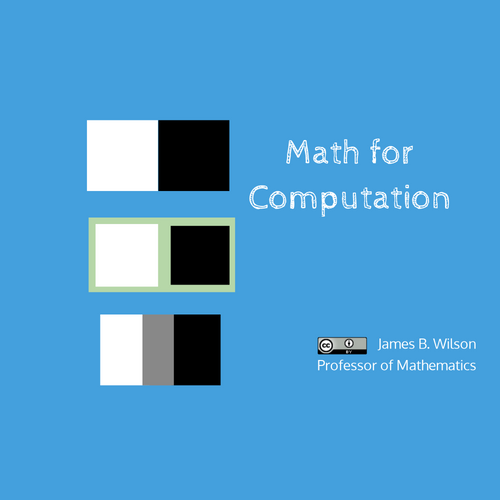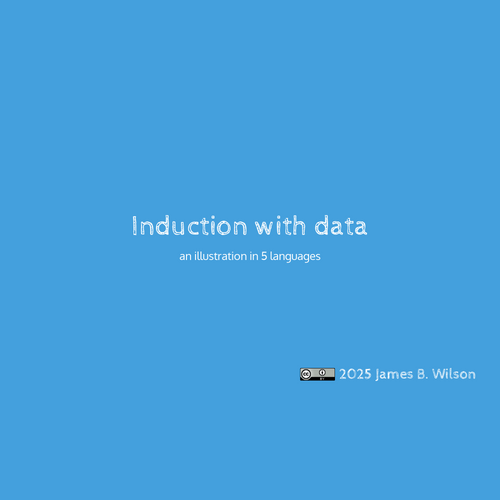-

Back Propogation
We will explore the idea of integrable systems.
-

Derivations
We will explore the idea of integrable systems.
-

Integrable systems
We will explore the idea of integrable systems.
-

Codata
We explore the reasons for codata and how they lead us to world of approximation and error analysis.
-

Adaptive Logic
Inductive reasoning assumes defaults, by listing the defaults and their order we can defeat reasoning that becomes faulty after event occur. It is a strategy to be have rationally in an irrational world.
-

Induction for proofs
Inductions is reasoning about data mixed with operations on that data.
-

Math for Computation
In the age of vibe coding what can reasoning offer to a modern programmer?
-

Induction
Inductions is reasoning about data mixed with operations on that data.
-

Copy of The Calculus
-

Characterizing Characteristic (50 mins)
Characteristic structure is information that does not change under isomorphisms. If you have all the isomorphisms you can verify this property. But we often need characteristic structure to find the isomorphisms: Chick-and-egg problem. This presentation reports on a new result that solve this problem.
-

The Calculus
-

Cluster Patterns Theory
A visual tour of how volume leads to tensors.
-

Programming Equals
-

Cluster Patterns For Everyone
A visual tour of how volume leads to tensors.
-

Cluster Patterns
A visual tour of how volume leads to tensors.
-

Exponentials
-

Tensors by volume
A visual tour of how volume leads to tensors.
-

Function Types
The function type is the natural evolution of logical implication.
-

Substitution
Substitution seems so obvious that we can be fooled by simple mistakes. Fixing them forces us into a logic and calculus to go with it. This is known as Lambda calculus and the rules we will use are by Curry-Feys. Come along for a playful tour of what goes wrong when we substitute.
-

Types & Programs
Demonstration of mathematical types and programming comparables.
-

Copy of Types of data
-

Implications for Process or Incident
Some implications involve resources which might not be available. So we cannot always discharge an implication without keeping track of how many times we have the necessary premises. When this happens we simply modify our rules of implication to include counting.
-

Implications with Resources
Some implications involve resources which might not be available. So we cannot always discharge an implication without keeping track of how many times we have the necessary premises. When this happens we simply modify our rules of implication to include counting.
-

False does not lead to truth, but context might
Implication is how we take one truth and turn it into a new one. It is enjoys a special place in science as the reason we do hypotheses and the mechanism to compute. However not everything about this operator is immediately obvious.
-

Logic of OR TRUE AND NOT
We are making our own logic so how hard can it be to make Or, True and Not? Surprises exist because we wont simply be shopping for these concepts already buried somewhere else. We are making them all natural from scratch! While I love these constructs I find them both subtle and worthy of multiple perspectives.
-

Sequent Calculus
Sequent calculus is a language to write logic. It uses few symbols with little to no meaning so that you can introduce just the meaning you want without the burden of all the implied ideas that normal language might provide. In exchange we get symbols which take practice to master.
-

Grammar's role in reasoning & programming
To make sure your logic is understood we go through language, and that means grammar. Fortunately most of logical grammar follows very basic rules.
-

Context for Logic
When you set up an argument you place it in a context and that can make all the difference.
-

Multiple Logics
A quick introduction to different forms of logic and how to recognize them.
-

Why are things different?
Why are things different? Explore the limits of structure and the external reasons for difference.
-

Copy of Programming with Universal Mapping Properties
Using universal mapping properties to prescribe data types and using resulting theory to build useful algorithms.
-

Tensor Contractions & Inflations
Tensors are defined by having contractions and cotensors by inflation. What are these and what do they require?
-

Please Distribute
What makes a tensor?
-

Copy of Open Education Resources
Open Education Resources
-

=
-

Characterizing Characteristic
Characteristic structure is information that does not change under isomorphisms. If you have all the isomorphisms you can verify this property. But we often need characteristic structure to find the isomorphisms: Chick-and-egg problem. This presentation reports on a new result that solve this problem.
-

Applied Combiantors: Intro to Programming Idioms
Many functions we use are built from simpler functions and that explains all the qualities of functions: predictable outputs for example. So where does this process get started? What are primitive functions?
-

Open Education Resources
Open Education Resources
-

Higher Inductive Types
Using universal mapping properties to prescribe data types and using resulting theory to build useful algorithms.
-

Copy of Copy of Tensor Products; Versor Fractions
-

QuantumFuture
A rough idea of how to get into quantum materials, quantum computing, or quantum whatever
-

IsometriesChar2
Intersecting classical groups in characteristic 2 is in P.
-

Programming with Universal Mapping Properties
Using universal mapping properties to prescribe data types and using resulting theory to build useful algorithms.
-

Copy of Tensor & Their Operators
Definitions and properties of tensors, tensor spaces, and their operators.
-

Copy of Tensor Products; Versor Fractions
-

Sub-sub-scripts
Reading mathematics that has subscripts begins rather naturally but can quickly descend into sub-sub-subscripts, relabeling, and lots of errors. A further stress happens when we discover that programming languages don't tolerate subscripts and so we find ourselves rethinking what it is we meant to say. This deck some strategies and the core reason that subscripts can be avoided
-

Tensor Products; Versor Fractions
-

deck
-

Denser Tensor Spaces
Definitions and properties of tensors, tensor spaces, and their operators.
-

Substitution Rules: Curry-Feys
Substitution needs rules. Curry-Feys is one such system and knowing how to substitute properly is worth the work.